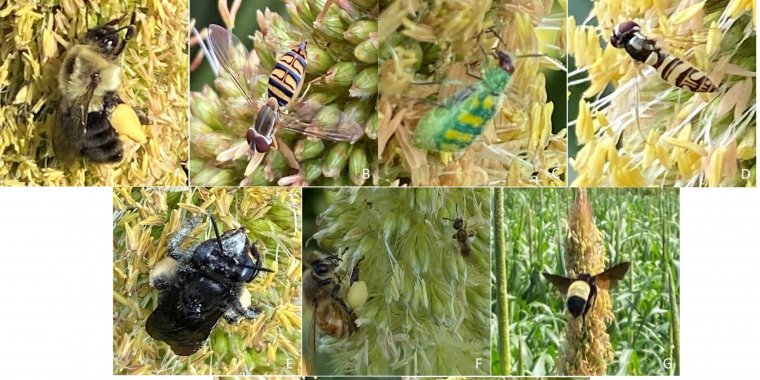| News / Science News |
Pearl millet, an annual grass used for grain and forage, can be a good food source for honey bees and hover flies
The United States Department of Agriculture (USDA)’s Agricultural Research Service (ARS) and University of Georgia College of Agricultural and Environmental Sciences researchers studied the impact of pearl millet as a source of insect food by surveying insects collecting and consuming the sucrose-rich pollen of this crop.

A common eastern bumble bee (A), maize calligrapher hover fly (B), cucumber beetle (C) exotic streaktail hover fly (D), two-spotted longhorn bee (E), western honey bee (F-left), sweat bee (F-right), American bumble bee (G). Photo: Karen Harris-Shultz, ARS
Researchers planted Tift Long-Headed Bulk, a type of pearl millet known for its long candlestick-like heads, at a research farm in Tifton, Georgia, during the past summer.
According to the survey results, the most common insects observed feeding on Tift Long-Headed Bulk pearl millet were honey bees followed by lined earwigs, and maize calligrapher hover flies.
Other pollinators such as two-spotted longhorn bees, common eastern bumble bees, American bumble bees, sweat bees, and two other species of hover flies also feasted on the crop.
“What makes the study and the results fascinating is that wind-pollinated grasses, like pearl millet, are rarely promoted as a food source of pollinators in comparison to nectar-rich plants,” said Karen Harris-Shultz, a research geneticist at the ARS Crop Genetics and Breeding Research Unit on the UGA Tifton campus. “Our research shows that pollinators are utilizing grass pollen.”
Harris-Shultz added that the study was also the first time that lined earwigs, banded cucumber beetles, two-spotted longhorn bees, and American bumble bees were observed collecting or consuming pollen from the pearl millet crop.
ARS researchers in Tifton previously studied pearl millet as a food source for pollinators in 1965, but that study has not been revisited since, according to Harris-Shultz.
Harris-Shultz and the researchers’ work focuses on bees and other pollinators of grasses, especially the turfgrass centipede grass and sorghum.
The researchers took an interest in pearl millet because of its ability to thrive in areas characterized by drought, low soil fertility, and high temperatures.
These traits make pearl millet, which is grown primarily in the southeastern United States, a low-input crop with great benefits for pollinators and farmers looking for a good field border plant.
“Contrary to popular belief that grasses have no value to bees and other pollinators, this and our previous studies showed that these grasses can be good food sources for insects and may help combat decline in pollinator populations,” said Harris-Shultz.
In addition to being pollinators, several of these insects, such as the hover flies and lined earwigs, are important biological control agents that assist in sustainable pest management.”
YOU MAY ALSO LIKE





